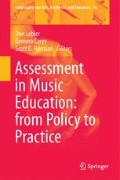Abstract
In this chapter I present a personal account of three different assessment strategies through which I sought to address fundamental challenges in the assessment of undergraduate music theory at the Queensland Conservatorium Griffith University. This chapter briefly identifies the main contextual challenges and illustrates how each of the three assessment practices may enhance learning, provide contextualized experiential referents to musical techniques, and emphasize student-driven learning. The examples illustrate the development of music analysis portfolios that include works chosen by the students and incorporate student self- and peer evaluating processes. I reflect on the use of various assessment techniques to enhance, guide, and inspire the work that students do for their analysis portfolios. The chapter also illustrates an alternative use of a computer multiple-choice test format that focuses as much on drilling as on condensing concepts that are relevant for informing musical interpretation for performance.
Access this chapter
Tax calculation will be finalised at checkout
Purchases are for personal use only
Notes
References
Beethoven, L. (1822–1825). Symphony no. 9 in D minor, Opus 125. http://imslp.org/wiki/Symphony_No.9,_Op.125_%28Beethoven,_Ludwig_van%29
Clendinning, J. P., & West Marvin, E. (2010). The musician’s guide to theory and analysis (2nd ed.). New York: W.W. Norton & Company.
Dee Fink, L. (2013). Creating significant learning experiences: An integrated approach to designing college courses (2nd ed.). San Francisco: Jossey-Bass.
Kostka, S., & Payne, J. D. (2008). Tonal harmony (6th ed.). New York: McGraw-Hill.
Mingus, C. (1959). Gunslinging Bird [aka If Charlie Parker were a Gunslinger, there’d be a Whole Lot of Dead Copycats]. On Mingus Dynasty [LP]. New York: Columbia Records.
Rogers, M. R. (2004). Teaching approaches in music theory: An overview of pedagogical philosophies. Carbondale, IL: Southern Illinois University.
Smith, E. L. (2013). Using a new taxonomy for significant learning in the theory classroom. Journal of Music Theory Pedagogy E-Journal, 1. Oklahoma: The Gail Boyd de Stwolinski Center for Music Theory Pedagogy. The University of Oklahoma. http://jmtp.ou.edu/e-journal
Author information
Authors and Affiliations
Corresponding author
Editor information
Editors and Affiliations
Rights and permissions
Copyright information
© 2015 Springer International Publishing Switzerland
About this chapter
Cite this chapter
Dirié, G. (2015). Assessments for Music Theory: Three Situations. In: Lebler, D., Carey, G., Harrison, S. (eds) Assessment in Music Education: from Policy to Practice. Landscapes: the Arts, Aesthetics, and Education, vol 16. Springer, Cham. https://doi.org/10.1007/978-3-319-10274-0_14
Download citation
DOI: https://doi.org/10.1007/978-3-319-10274-0_14
Published:
Publisher Name: Springer, Cham
Print ISBN: 978-3-319-10273-3
Online ISBN: 978-3-319-10274-0
eBook Packages: Humanities, Social Sciences and LawEducation (R0)

